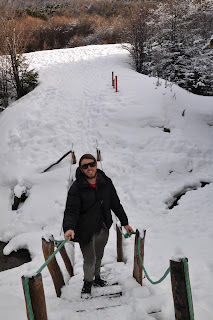Part 3...
 |
| The most beautiful walk in the world? |
From Ushuaia we retrace our steps to Punta Arenas. A 2hr border crossing delays us and we are late for our connection (border crossings are futile. Our bags are unloaded, scanned, sniffered, reloaded. Passports and documents are signed and stamped in triplicate. The bus then crawls 50m across an arbitrary line in the desert and the whole process is repeated in Chile. The customs officers show less than no interest to x-ray tv. Despite signs everywhere indicating the penalties for not declaring fruit and veg, we are are waved on without even getting our apples from their bag. No wonder MAF have such a difficult time getting tourists arriving in NZ to take it seriously).
We scramble off the bus and Nic dashes off to chase down the connecting bus, while I grab the bags. Despite all the (mostly non-verbal) urgency communicated to the conductor he's in no rush to unload the baggage. He chats casually to street vendors. I've had enough and toss open the luggage door. Casting suitcases aside on the street I haul out our packs and set-off down the street, half expecting to be tackled at any moment for an alleged theft. I arrive at the next bus station to find Nic, teapot, standing stubbornly blocking the way of a bright orange, double-decker bus with driver and conductor glaring through the windshield. We hop on, avoiding all eye-contact as we take our place in the back row.
 |
| Wordplay at its finest |
The destination this time is Puerto Natales, from where we based ourselves before heading out to walk in the Torres del Paine National Park.
Here's the info if you want it - if you've seen an ad for Patagonia, chances are the pictures will have been taken at Torres del Paine. We are fortunate to find that the only other guests at our hostel in Puerto Natales are a friendly Chilean couple working as guides in the park. They speak very good english and are happy to share with us their advice. Like, for example, there is more snow in the park than there has been in the last 10 years. And that a big chunk of the track is probably inaccessible.
As we make our way around the town to hire equipment for the trek, we get some feedback from incredulous salesmen. You want to hire a tent?! You realise there's a lot of snow in the park? And that the refugios aren't open in winter? The forecast doesn't look fantastic either. Sunshine for the following day, but rain from there on - a park trademark. The TDP website says emphatically: bring quick drying, synthetic clothing only; our packs are full with wool and goose down.
We have a restless night wondering whether this might be a mistake, but there's little sleep to lose as the All Blacks are playing at 5am and the bus to the park arrives at 7am.
Thankfully, all our fears are dispelled as we walk along the access road to the beginning of the trail. As it's off-season there's no shuttle service offered across this section, but the spectacular views of the towers (torres) are worth the extra walk.
The most popular trail in the park forms a 'W' shape around the base of two large mountainous outcrops, which can be walked in either direction. We decided to start at the towers end, knowing the weather was meant to be at its best on day 1. However a quick check in with the guys at the hosteria (hosteria las torres on the map below) confirms the snow situation - it is waist deep on the track to the towers, the return walk would take at least 7 hours and it's already midday. After a bit of umming and ah-ing, we decide to cut our losses and make the most of the sunshine, heading around the base of the W to Campamento Italiano.
 |
| Kind of like a Magic Eye picture, you can make out a green 'W' if you squint a little |
 |
| Lago Nordenskjöld in the foreground and Lago Sarmiento in the background surrounded by a ring of white rock |
The walk around the base of the towers offered stunning views of the lakes and mountains of the park. With each hill or corner in the trail there was seemingly always something new to marvel at.
 |
| The Cuernos (Horns) del Paine |
Camp Italiano is located in the cleavage of the 'W' and just down the valley from a retreating glacier. We arrive in twilight and get busy setting up the tent. After a dinner of simple pasta (but made all the more tasty with the commonest of camping spices: fatigue and a clear night sky) we prepare ourselves for a Patagonian winter night. Thermals, puffer jackets, wooly hats, gloves and socks, and hot water bottles (Mr & Mrs Mitchell, we thank thee for the brilliant tip of filling our aluminum bottles with boiling water) all inside the sleeping bag. It's with equal measures of relief and disappointment that we both get far too hot and have to strip off layers during the night. All the while the campsite is brought alive by the thunderous crashing sounds echoing through the valley as parts of the glacier tumble down.
 |
| Glimpse of one of the many avalanches we saw and heard on day 2 |
Day 2 is a hike up the French Valley under blue skies. We're able to leave our packs at the camp, which is a bonus, because the snow is thigh deep in places. From Campamento Britanico further up the valley the views are panoramic.
Wow. Long post. Much shorter next time, promise. And some summer clothes photos too (we're writing this from Buenos Aires and it's 25 degrees. Goodbye puffer jacket). Bring on the wedding party celebrations!
Nic & George x



















































